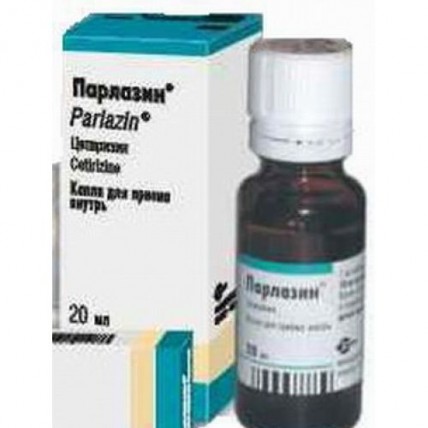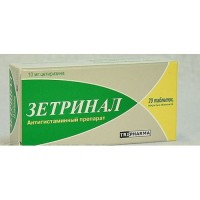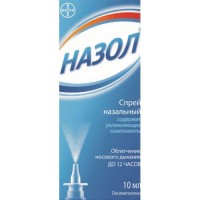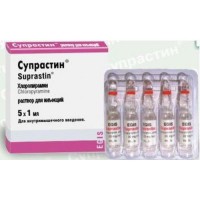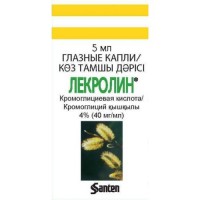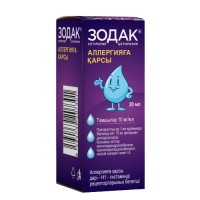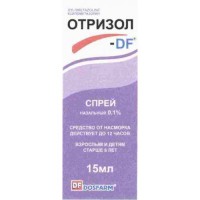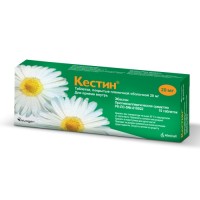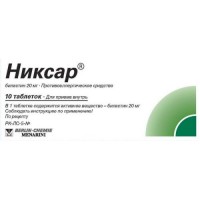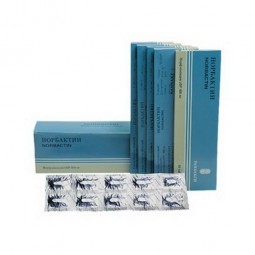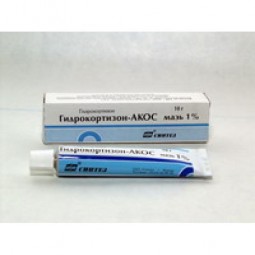Parlazin 20ml drops for oral administration children
- $18.20
The instruction for medical use
of PARLAZIN medicine
the Trade name
Parlazin
Mezhdunarodnoye the unlicensed
name Tsetirizin Lekarstvennaya
the Drop form for intake, 10mg/ml
Structure
of 20 ml of solution contains
active agent of a tsetirizin dihydrochloride of 200 mg,
excipients: glycerin of 85%, propylene glycol, sodium saccharinate, acetate sodium trihydrate, methylparahydroxybenzoate, propyl-parahydroxybenzoate, the ice acetic acid, water purified.
The description
Colourless sweet liquid without deposit, with a slight characteristic smell of acetic acid.
Pharmacotherapeutic group
Antihistaminic drugs of systemic action. Piperazin derivatives. Tsetirizin.
The ATX R06AE07 code
the Pharmacological
Pharmacokinetics Equilibrium Maximum Concentration properties makes about 300 ng/ml and is reached during 1.0 & plusmn, 0.5 hours. Tsetirizin in a dose of 10 mg/day at a repeated dosage within 10 days did not accumulate. Volunteers have pharmacokinetic parameters (Smakh and AUC) and distribution have unimodal character. Food does not influence extent of absorption though the speed of absorption goes down. Degree of bioavailability is similar when using a tsetirizin in the form of solution, capsules or tablets. The seeming volume of distribution is 0.50 l/kg. Linking of a tsetirizin with proteins of blood plasma 93 & plusmn, 0.3%. Tsetirizin does not influence linking of warfarin with proteins of plasma. Tsetirizin is not exposed to the significant predistemny metabolism.
About 2/3 doses are removed in an invariable form with urine. Elimination half-life makes about 10 hours. Tsetirizin has linear kinetics in the range of doses from 5 to 60 mg.
Patients of advanced age
At 16 test patients of advanced age after single dose in a dose of a tsetirizin of 10 mg time of semi-removal increased approximately by 50%, and the clearance was reduced by 40%, in comparison with persons not of advanced age. Decrease in clearance of a tsetirizin at elderly people it is possibly connected with deterioration in renal function.
Children
Elimination half-life of a tsetirizin makes about 6 hours at children aged from 6 up to 12 years, aged from 2 up to 6 years - 5 hours, aged from 6 months up to 2 years about 3.1 hours.
Patients with a renal failure
At patients to a slight renal failure (KK & gt, 40 ml/min.) the pharmacokinetics of drug was similar to pharmacokinetics of healthy volunteers. In a moderate renal failure, in comparison with healthy volunteers, elimination half-life increases by 3 times, and the clearance went down for 70%.
In comparison with healthy volunteers, at patients on a hemodialysis (KK ˂ 7 ml/min.) after single dose of a dose of a tsetirizin of 10 mg the elimination half-life raised by 3 times, and the clearance went down for 70%. Tsetirizin badly leaves by means of a hemodialysis. In a moderate-heavy renal failure the dose adjustment is necessary.
Patients with an abnormal liver function
At the patients with a chronic abnormal liver function (hepatocellular, cholestatic or biliary cirrhosis) receiving a single dose of 10 mg or 20 mg of a tsetirizin elimination half-life increased by 50%, and the clearance decreased by 40%, in comparison with healthy faces.
Change of a dose is necessary only at patients with a simultaneous abnormal liver function and kidneys.
The pharmacodynamics
Tsetirizin - Hydroxyzinum metabolite, is a selective antagonist of peripheral H1 - histamine receptors. In experiments on linking with receptors in the conditions of in vivo the measured affinity of drug to the receptors different from H1 is not revealed. Except anti-Н1 effect, tsetirizin also has antiallergic activity: in a dose of 10 mg at reception 1 or 2 times a day it inhibits migration of eosinophils in a late phase in skin and a conjunctiva at the persons suffering from an atopy after provocative test with allergen.
Researches on healthy volunteers showed what tsetirizin in a dose of 5 and 10 mg strongly inhibits the triple answer (skin reaction as blossoming) caused by very high concentrations of a histamine in skin, however the correlation with efficiency is not established.
Indications
- seasonal and year-round allergic rhinitis and conjunctivitis
- a chronic idiopathic small tortoiseshell
the Route of administration and doses
Adults and teenagers are more senior than 12 years: the recommended dose of 10 mg once a day (20 drops), it is preferable for the night.
Maximum daily and maximum single dose of 10 mg (20 drops).
Children at the age of 6-12 years: the recommended dose on 5 mg (10 drops) two times a day in the morning and in the evening
Children at the age of 2-6 years: the recommended dose of 5 mg (10 drops a day). It is also possible to divide this dose into two receptions on 2.5 mg (on 5 drops in the morning and in the evening).
Children at the age of 1 year-2 years: 2.5 mg 2 times a day (5 drops).
Maximum single dose of 2.5 mg (5 drops) and maximum daily dose of 5 mg (10 drops).
Patients of advanced age:
At normal function of kidneys the age is not the reason for reduction of a dose.
To patients with a renal failure appoint a half of the recommended dose.
Duration of treatment is defined by the doctor individually depending on a clinical condition of the patient.
Patients with a renal failure of medium-weight degree should establish frequency of introduction individually according to function of kidneys. In the table given below necessary changes of a dose are specified. For use of this table it is necessary to estimate clearance of creatinine at the patient (Clcr) at ml/min. After determination of level of creatinine of blood serum (mg/dl) the Clcr value (ml/min.) can be estimated on the following formula:
For men:
MM)
for women: the received
Dose adjustment value 0.85 at patients with diseases of kidneys:
The Dose Clearance of Creatinine group and frequency of reception
Normal function of kidneys
& ge, 80
10 mg once a day
A moderate renal failure
of 50-79
10 mg once a day
A renal failure of average degree
of 30-49
5 mg once a day
The heavy renal failure
of ˂30
5 mg of 1 times in 2 days
A renal failure, dialysis
& le, 10
is contraindicated
To children with renal failures a dose it is necessary to select individually, taking into account renal clearance and also age and body weight of the patient.
Patients with abnormal liver functions
to the Patients having only abnormal liver functions are not present need for dose adjustment.
Patients with abnormal liver functions and kidneys
dose adjustment Is recommended.
Side effects
Often (& ge, 1/100 - & lt, 1/10)
- sedation dependent on a dose
- feeling of fatigue
- a headache, dizziness
Infrequently (& ge, 1/1.000 - & lt, 1/100)
- excitement
- paresthesia
- diarrhea
- an itching, rash
- an asthenia, feeling sick
Is rare (& ge, 1/10.000 - & lt, 1/1.000)
- hypersensitivity
- aggression, confusion of consciousness, a depression, hallucinations, insomnia
- spasms, disturbances of movements
- tachycardia
- changes of function of a liver (increase in level of transaminases, alkaline phosphatase, - GT and bilirubin)
- a small tortoiseshell
- hypostases
- increase in body weight
is Very rare (& lt, 1/10000)
- thrombocytopenia
- an acute anaphylaxis
- a tic
- disturbance of taste, a syncope (faint), a tremor, dystonia, dyskinesia
- a Quincke's disease, the fixed toxidermia (the reaction arising on the same place)
- disturbance of visual accommodation, illegibility of sight, an okulogirny syndrome
- the dysuria, enuresis
Frequency is unknown
- the increased appetite, amnesia, memory disturbance, dizziness, an ischuria, suicide thoughts
of the Contraindication
- hypersensitivity to a tsetirizin or other components of drug
- a heavy renal failure if clearance of creatinine ˂ 10 ml/min.
- children's age till 1 year
- pregnancy and the period of a lactation
Medicinal interactions
Pharmacokinetic researches of interaction of a tsetirizin and pseudoephedrine, antipyrine, Cimetidinum, a ketokonazol, erythromycin, azithromycin of a glipizid, diazepam did not reveal any proofs of adverse pharmakodinamichesky interactions.
In several researches of doses of theophylline (400 mg once a day) and a tsetirizina, decrease in clearance of a tsetirizin was observed small (16%) while the arrangement of theophylline was not changed at co-administration of a tsetirizin.
At co-administration of a tsetirizin with macroleads (for example, azithromycin, erythromycin) or ketokonazoly did not lead to clinically significant changes of the ECG.
At a research of several doses of a ritonavir (600 mg twice a day) and a tsetirizina (10 mg a day) it was revealed that extent of influence of a tsetirizin was increased approximately by 40%, and the arrangement of a ritonavir was slightly changed (-11%) in addition to the accompanying reception of a tsetirizin. Tsetirizin weakens anticoagulating effect of heparin sodium. Azelastin, to alprazola, buprenorphine, a haloperidol, Hydroxyzinum, diazepam, Droperidolum, zolpidy, flurazepam, kvetiapin, Fluphenazin, clozapine, trifluoperazin, thioridazine, phenobarbital, fentanyl, temazepam, risperidon, propofol, remifentanit, promethazine, Perfenazinum, codeine, lorazepam, olanzapine, oxazepam, midazolam, Chlorpromazinum, chlordiazepoxide, to estazola strengthens (mutually) a deprimation and reduction in the rate of psychomotor reactions.
Metohexital, ketamine, izofluran, enfluran in the post-narcotic period - strengthens (mutually) a deprimation and reduction in the rate of psychomotor reactions. Ethanol - strengthens (mutually) a deprimation and reduction in the rate of psychomotor reactions therefore during treatment it is necessary to refuse consumption of alcoholic drinks.
Extent of absorption of a tsetirizin does not decrease with meal though the speed of absorption decreases for 1 hour.
Tests for a skin allergy are suppressed with antihistamines, their washing away happens within 3 days, it is recommended to pay attention to it before carrying out them.
Meal does not reduce absorption of a tsetirizin though the speed of absorption goes down.
The special
instructions Treatment Parlazinom should be stopped in 3 days prior to carrying out Prik-testa (alergotest in the form of a skin scratch) for the purpose of prevention of distortion of reaction.
Parlazin it is necessary to apply with care at patients with epilepsy and persons with risk of developing spasms.
Drug excipients methyl-parahydroxybenzoate and propyl - parahydroxybenzoate can cause allergic reactions of the slowed-down type.
In therapeutic doses the clinically apparent interaction of Parlazin with alcohol (was not observed at the blood alcohol level of 0.5 g/l). Nevertheless, it is necessary to be careful at combined use of Parlazin with alcohol.
Use in pediatrics
Use of the drug Parlazin for children is younger than 1 year it is not recommended.
Features of influence of medicine on ability to run the vehicle or potentially dangerous mechanisms.
At the first reception of Parlazin it is necessary to pay attention to a possibility of development of side effects (drowsiness). Patients are recommended to abstain from driving of the car or control of mechanical devices before disappearance of side effects. Further in need of driving of motor transport or when carrying out the works requiring special attention, patients should not exceed a daily dose of 10 mg.
Overdose
Symptoms: the side reactions registered after reception of a dose of Parlazin by 5 times exceeding the recommended daily dose - confusion of consciousness, diarrhea, dizziness, fatigue, feeling sick, a mydriasis, an itching, concern, a sedation. Drowsiness, stupor, tachycardia, tremor, ischuria.
Treatment: it is necessary to cause vomiting and also to appoint the symptomatic and supporting treatment. Specific antidote does not exist. For removal of drug from blood the hemodialysis is not effective.
A form of release and packing
On 20 ml in a bottle from brown glass, corked by a polyethylene stopper dropper and a cover polypropylene with an inside polyethylene layer, the supplied special protection against opening by children and control of the first opening. Each bottle is pasted over with the label self-adhesive. On 1 bottle together with the instruction for medical use in the state and Russian languages put in a pack from cardboard.
To Store storage conditions at a temperature not over 250C.
Not to freeze!
To store in the inaccessible place for children!
4 years
the Open bottle to store a period of storage 6 weeks
not to use after an expiration date.
Prescription status
According to the prescription
BUDAPEST CJSC EGIS PHARMATSEVTICHESKY PLANT Producer 1106, Keresturi St., 30-38 Hungary
Phone number: (36-1) 803-5555, the fax: (36-1) 803-5529
Owner of the registration certificate
of CJSC Pharmatsevtichesky Zavod egis, Hungary
the Address of the organization accepting in the territory of the Republic of Kazakhstan claims from consumers on quality of products (goods)
Representation in RK CJSC Pharmatsevtichesky Zavod egis
050060, Almaty, Zharokov St. of 286 G
ph. + 7 (727) 247 63 34, + 7 (727) 247 63 33, fax: + 7 (727) 247 61 41
e-mail:
To develop egis@egis.kz
of PARLAZIN medicine
the Trade name
Parlazin
Mezhdunarodnoye the unlicensed
name Tsetirizin Lekarstvennaya
the Drop form for intake, 10mg/ml
Structure
of 20 ml of solution contains
active agent of a tsetirizin dihydrochloride of 200 mg,
excipients: glycerin of 85%, propylene glycol, sodium saccharinate, acetate sodium trihydrate, methylparahydroxybenzoate, propyl-parahydroxybenzoate, the ice acetic acid, water purified.
The description
Colourless sweet liquid without deposit, with a slight characteristic smell of acetic acid.
Pharmacotherapeutic group
Antihistaminic drugs of systemic action. Piperazin derivatives. Tsetirizin.
The ATX R06AE07 code
the Pharmacological
Pharmacokinetics Equilibrium Maximum Concentration properties makes about 300 ng/ml and is reached during 1.0 & plusmn, 0.5 hours. Tsetirizin in a dose of 10 mg/day at a repeated dosage within 10 days did not accumulate. Volunteers have pharmacokinetic parameters (Smakh and AUC) and distribution have unimodal character. Food does not influence extent of absorption though the speed of absorption goes down. Degree of bioavailability is similar when using a tsetirizin in the form of solution, capsules or tablets. The seeming volume of distribution is 0.50 l/kg. Linking of a tsetirizin with proteins of blood plasma 93 & plusmn, 0.3%. Tsetirizin does not influence linking of warfarin with proteins of plasma. Tsetirizin is not exposed to the significant predistemny metabolism.
About 2/3 doses are removed in an invariable form with urine. Elimination half-life makes about 10 hours. Tsetirizin has linear kinetics in the range of doses from 5 to 60 mg.
Patients of advanced age
At 16 test patients of advanced age after single dose in a dose of a tsetirizin of 10 mg time of semi-removal increased approximately by 50%, and the clearance was reduced by 40%, in comparison with persons not of advanced age. Decrease in clearance of a tsetirizin at elderly people it is possibly connected with deterioration in renal function.
Children
Elimination half-life of a tsetirizin makes about 6 hours at children aged from 6 up to 12 years, aged from 2 up to 6 years - 5 hours, aged from 6 months up to 2 years about 3.1 hours.
Patients with a renal failure
At patients to a slight renal failure (KK & gt, 40 ml/min.) the pharmacokinetics of drug was similar to pharmacokinetics of healthy volunteers. In a moderate renal failure, in comparison with healthy volunteers, elimination half-life increases by 3 times, and the clearance went down for 70%.
In comparison with healthy volunteers, at patients on a hemodialysis (KK ˂ 7 ml/min.) after single dose of a dose of a tsetirizin of 10 mg the elimination half-life raised by 3 times, and the clearance went down for 70%. Tsetirizin badly leaves by means of a hemodialysis. In a moderate-heavy renal failure the dose adjustment is necessary.
Patients with an abnormal liver function
At the patients with a chronic abnormal liver function (hepatocellular, cholestatic or biliary cirrhosis) receiving a single dose of 10 mg or 20 mg of a tsetirizin elimination half-life increased by 50%, and the clearance decreased by 40%, in comparison with healthy faces.
Change of a dose is necessary only at patients with a simultaneous abnormal liver function and kidneys.
The pharmacodynamics
Tsetirizin - Hydroxyzinum metabolite, is a selective antagonist of peripheral H1 - histamine receptors. In experiments on linking with receptors in the conditions of in vivo the measured affinity of drug to the receptors different from H1 is not revealed. Except anti-Н1 effect, tsetirizin also has antiallergic activity: in a dose of 10 mg at reception 1 or 2 times a day it inhibits migration of eosinophils in a late phase in skin and a conjunctiva at the persons suffering from an atopy after provocative test with allergen.
Researches on healthy volunteers showed what tsetirizin in a dose of 5 and 10 mg strongly inhibits the triple answer (skin reaction as blossoming) caused by very high concentrations of a histamine in skin, however the correlation with efficiency is not established.
Indications
- seasonal and year-round allergic rhinitis and conjunctivitis
- a chronic idiopathic small tortoiseshell
the Route of administration and doses
Adults and teenagers are more senior than 12 years: the recommended dose of 10 mg once a day (20 drops), it is preferable for the night.
Maximum daily and maximum single dose of 10 mg (20 drops).
Children at the age of 6-12 years: the recommended dose on 5 mg (10 drops) two times a day in the morning and in the evening
Children at the age of 2-6 years: the recommended dose of 5 mg (10 drops a day). It is also possible to divide this dose into two receptions on 2.5 mg (on 5 drops in the morning and in the evening).
Children at the age of 1 year-2 years: 2.5 mg 2 times a day (5 drops).
Maximum single dose of 2.5 mg (5 drops) and maximum daily dose of 5 mg (10 drops).
Patients of advanced age:
At normal function of kidneys the age is not the reason for reduction of a dose.
To patients with a renal failure appoint a half of the recommended dose.
Duration of treatment is defined by the doctor individually depending on a clinical condition of the patient.
Patients with a renal failure of medium-weight degree should establish frequency of introduction individually according to function of kidneys. In the table given below necessary changes of a dose are specified. For use of this table it is necessary to estimate clearance of creatinine at the patient (Clcr) at ml/min. After determination of level of creatinine of blood serum (mg/dl) the Clcr value (ml/min.) can be estimated on the following formula:
For men:
MM)
for women: the received
Dose adjustment value 0.85 at patients with diseases of kidneys:
The Dose Clearance of Creatinine group and frequency of reception
Normal function of kidneys
& ge, 80
10 mg once a day
A moderate renal failure
of 50-79
10 mg once a day
A renal failure of average degree
of 30-49
5 mg once a day
The heavy renal failure
of ˂30
5 mg of 1 times in 2 days
A renal failure, dialysis
& le, 10
is contraindicated
To children with renal failures a dose it is necessary to select individually, taking into account renal clearance and also age and body weight of the patient.
Patients with abnormal liver functions
to the Patients having only abnormal liver functions are not present need for dose adjustment.
Patients with abnormal liver functions and kidneys
dose adjustment Is recommended.
Side effects
Often (& ge, 1/100 - & lt, 1/10)
- sedation dependent on a dose
- feeling of fatigue
- a headache, dizziness
Infrequently (& ge, 1/1.000 - & lt, 1/100)
- excitement
- paresthesia
- diarrhea
- an itching, rash
- an asthenia, feeling sick
Is rare (& ge, 1/10.000 - & lt, 1/1.000)
- hypersensitivity
- aggression, confusion of consciousness, a depression, hallucinations, insomnia
- spasms, disturbances of movements
- tachycardia
- changes of function of a liver (increase in level of transaminases, alkaline phosphatase, - GT and bilirubin)
- a small tortoiseshell
- hypostases
- increase in body weight
is Very rare (& lt, 1/10000)
- thrombocytopenia
- an acute anaphylaxis
- a tic
- disturbance of taste, a syncope (faint), a tremor, dystonia, dyskinesia
- a Quincke's disease, the fixed toxidermia (the reaction arising on the same place)
- disturbance of visual accommodation, illegibility of sight, an okulogirny syndrome
- the dysuria, enuresis
Frequency is unknown
- the increased appetite, amnesia, memory disturbance, dizziness, an ischuria, suicide thoughts
of the Contraindication
- hypersensitivity to a tsetirizin or other components of drug
- a heavy renal failure if clearance of creatinine ˂ 10 ml/min.
- children's age till 1 year
- pregnancy and the period of a lactation
Medicinal interactions
Pharmacokinetic researches of interaction of a tsetirizin and pseudoephedrine, antipyrine, Cimetidinum, a ketokonazol, erythromycin, azithromycin of a glipizid, diazepam did not reveal any proofs of adverse pharmakodinamichesky interactions.
In several researches of doses of theophylline (400 mg once a day) and a tsetirizina, decrease in clearance of a tsetirizin was observed small (16%) while the arrangement of theophylline was not changed at co-administration of a tsetirizin.
At co-administration of a tsetirizin with macroleads (for example, azithromycin, erythromycin) or ketokonazoly did not lead to clinically significant changes of the ECG.
At a research of several doses of a ritonavir (600 mg twice a day) and a tsetirizina (10 mg a day) it was revealed that extent of influence of a tsetirizin was increased approximately by 40%, and the arrangement of a ritonavir was slightly changed (-11%) in addition to the accompanying reception of a tsetirizin. Tsetirizin weakens anticoagulating effect of heparin sodium. Azelastin, to alprazola, buprenorphine, a haloperidol, Hydroxyzinum, diazepam, Droperidolum, zolpidy, flurazepam, kvetiapin, Fluphenazin, clozapine, trifluoperazin, thioridazine, phenobarbital, fentanyl, temazepam, risperidon, propofol, remifentanit, promethazine, Perfenazinum, codeine, lorazepam, olanzapine, oxazepam, midazolam, Chlorpromazinum, chlordiazepoxide, to estazola strengthens (mutually) a deprimation and reduction in the rate of psychomotor reactions.
Metohexital, ketamine, izofluran, enfluran in the post-narcotic period - strengthens (mutually) a deprimation and reduction in the rate of psychomotor reactions. Ethanol - strengthens (mutually) a deprimation and reduction in the rate of psychomotor reactions therefore during treatment it is necessary to refuse consumption of alcoholic drinks.
Extent of absorption of a tsetirizin does not decrease with meal though the speed of absorption decreases for 1 hour.
Tests for a skin allergy are suppressed with antihistamines, their washing away happens within 3 days, it is recommended to pay attention to it before carrying out them.
Meal does not reduce absorption of a tsetirizin though the speed of absorption goes down.
The special
instructions Treatment Parlazinom should be stopped in 3 days prior to carrying out Prik-testa (alergotest in the form of a skin scratch) for the purpose of prevention of distortion of reaction.
Parlazin it is necessary to apply with care at patients with epilepsy and persons with risk of developing spasms.
Drug excipients methyl-parahydroxybenzoate and propyl - parahydroxybenzoate can cause allergic reactions of the slowed-down type.
In therapeutic doses the clinically apparent interaction of Parlazin with alcohol (was not observed at the blood alcohol level of 0.5 g/l). Nevertheless, it is necessary to be careful at combined use of Parlazin with alcohol.
Use in pediatrics
Use of the drug Parlazin for children is younger than 1 year it is not recommended.
Features of influence of medicine on ability to run the vehicle or potentially dangerous mechanisms.
At the first reception of Parlazin it is necessary to pay attention to a possibility of development of side effects (drowsiness). Patients are recommended to abstain from driving of the car or control of mechanical devices before disappearance of side effects. Further in need of driving of motor transport or when carrying out the works requiring special attention, patients should not exceed a daily dose of 10 mg.
Overdose
Symptoms: the side reactions registered after reception of a dose of Parlazin by 5 times exceeding the recommended daily dose - confusion of consciousness, diarrhea, dizziness, fatigue, feeling sick, a mydriasis, an itching, concern, a sedation. Drowsiness, stupor, tachycardia, tremor, ischuria.
Treatment: it is necessary to cause vomiting and also to appoint the symptomatic and supporting treatment. Specific antidote does not exist. For removal of drug from blood the hemodialysis is not effective.
A form of release and packing
On 20 ml in a bottle from brown glass, corked by a polyethylene stopper dropper and a cover polypropylene with an inside polyethylene layer, the supplied special protection against opening by children and control of the first opening. Each bottle is pasted over with the label self-adhesive. On 1 bottle together with the instruction for medical use in the state and Russian languages put in a pack from cardboard.
To Store storage conditions at a temperature not over 250C.
Not to freeze!
To store in the inaccessible place for children!
4 years
the Open bottle to store a period of storage 6 weeks
not to use after an expiration date.
Prescription status
According to the prescription
BUDAPEST CJSC EGIS PHARMATSEVTICHESKY PLANT Producer 1106, Keresturi St., 30-38 Hungary
Phone number: (36-1) 803-5555, the fax: (36-1) 803-5529
Owner of the registration certificate
of CJSC Pharmatsevtichesky Zavod egis, Hungary
the Address of the organization accepting in the territory of the Republic of Kazakhstan claims from consumers on quality of products (goods)
Representation in RK CJSC Pharmatsevtichesky Zavod egis
050060, Almaty, Zharokov St. of 286 G
ph. + 7 (727) 247 63 34, + 7 (727) 247 63 33, fax: + 7 (727) 247 61 41
e-mail:
To develop egis@egis.kz
